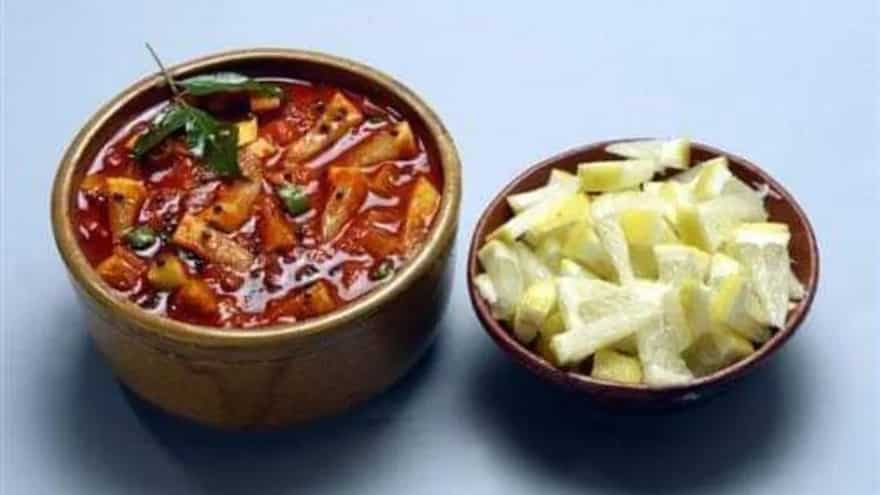Naranga Achaar is a lemon pickle that is a part of the cuisine of Kerala, made with lemons, spices, and herbs soaked in sesame oil. This achaar is an integral part of the ‘Sadya’ meal during Onam.
A South Asian pickle, also known as Avalehikā, Pachchadi, Achaar, Athaanu, Loncha, Oorugaai or Aavakaai is a pickled food, native to India, made from different vegetables and fruits, preserved in brine, vinegar or edible oils alongwith spices.
Lime is an essential ingredient in Indian cuisines including sweetened lime pickle, salted lemon pickle and lime chutney. Preparation depends on region but largely lemons are diced, mixed with spices such as mustard seed, chillies and turmeric, tossed with salt and then left covered in the sun for weeks.
In India, there are two main types of pickles, one made in sesame or mustard oil, and the other without oil. Non-oil-based pickles use salt to draw out the moisture from fruits or vegetables to create their own brine. A mixture of lemon or lime juice with salt is also used as brine.

Preparation time: 10 minutes
Cooking time: 30 minutes
Servings: 10-12
Ingredients:
- 8 - medium sized lemons
- 10 - garlic cloves (peeled skin and julienned)
- 1 - large green chili (sliced)
- 1 - tbsp ginger
- ½ cup - gingelly oil (sesame oil)
- 1 tbsp - mustard seeds
- 3 tbsp - chilly powder
- ¼ tsp - ground fenugreek
- A pinch of asafoetida
- 2 tsp - white vinegar
- Salt to taste
- A sprig of curry leaves
- Water as needed
Method:
- In a steamer, add lemons and cook for 8-10 minutes
- Remove them from steamer and pat dry
- In a heavy bottomed pan, add 2 tbsp of oil, lemons and shallow fry them for 2-3 minutes
- Turn off the heat and allow them to cool, then cut them into small pieces
- In a bowl add lemons, salt, mix well and set aside for 10 minutes
- In a pan heat oil, add mustard seeds, let them sputter
- Add curry leaves, ginger and garlic
- Reduce the flame to low and add chilli powder, ground fenugreek and asafoetida
- Now add lemons, mix well, add vinegar and salt to taste
- Add enough water to cover lemons, and mix well
- Bring this mixture to a boil and let it simmer for 2-3 minutes
- Turn off the heat and allow it to cool
Sadya is always served in pankthi – the word for ‘line’ in Sanskrit (also called ‘panthi’ in Malayalam) meaning where sets of people are served when they are seated in lines – either on the floor as was the custom earlier and now at dining tables. Depending upon the size of the crowd and the capacity of the venue, people sit in many pankthis to eat the Sadya. The host normally sits to eat during the last pankthi. He goes to every pankthi to greet the guests, ensuring that they’ve had a hearty meal.


